 The first time I ever saw Lazair fly — a fly-in at the Tullahoma Airport, as I recall — a then-young Peter Corley flew the lightweight aircraft as though he was the pilot of a military fighter of the day. He pushed the sleek machine with the whining engines as he looped and rolled the machine with such apparent ease. At this early time of development for these aircraft, such maneuvers in what we called an ultralight were very unusual.
The first time I ever saw Lazair fly — a fly-in at the Tullahoma Airport, as I recall — a then-young Peter Corley flew the lightweight aircraft as though he was the pilot of a military fighter of the day. He pushed the sleek machine with the whining engines as he looped and rolled the machine with such apparent ease. At this early time of development for these aircraft, such maneuvers in what we called an ultralight were very unusual.
To say either Peter or Lazair was unusual proved something of an understatement. Lazair was, and remains, one of the most unorthodox aircraft of any kind. Several reasons stand out to define its uniqueness.
These differences included: an inverted-V tail, said to be the most efficient tail planform; twin engines (the tiniest ones imaginable); an aluminum structure not based solely on round tubing; and see-through wing and tail coverings. All that is just the overview.
UltraFlight Lazair
The Lazair single seat ultralight aircraft was designed by Dale Kramer and the late Peter Corley and produced by UltraFlight Incorporated in Port Colborne, Ontario Canada.
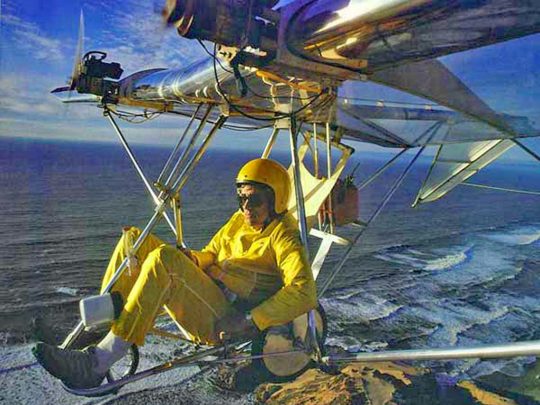 Lazair entered the market in the early 1980s and was sold in kit form. Kits took between 500 and 1,000 hours to build as they were basically a raw materials kit. The fuselage and tail section use aluminum tubing with bolt and rivet construction.
Lazair entered the market in the early 1980s and was sold in kit form. Kits took between 500 and 1,000 hours to build as they were basically a raw materials kit. The fuselage and tail section use aluminum tubing with bolt and rivet construction.
Wings featured an aluminum D-cell construction with styrofoam ribs. These structures were covered in a Mylar or Tedlar fabric.
Lazair is a high-wing, strut-braced, tricycle-gear taildragger. Engines were in tractor configuration with an inverted-V tail equipped with ruddervators.
Dale developed Lazair into in several different variations, still as a single-place ultralight, the last being the Series III.
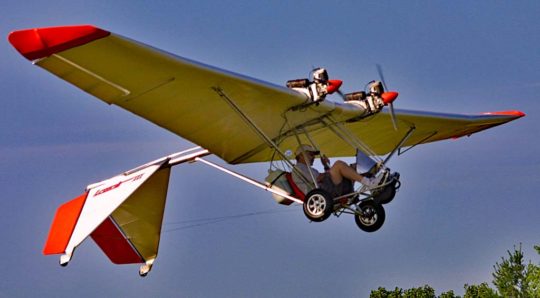 Power was originally supplied by two modified Pioneer Chainsaw engines of approximately 5.5 horsepower each. The Series 2 and 3 models used two, single-cylinder, 9.5-horsepower Rotax engines. These engines were mounted on the leading edge of the wings.
Power was originally supplied by two modified Pioneer Chainsaw engines of approximately 5.5 horsepower each. The Series 2 and 3 models used two, single-cylinder, 9.5-horsepower Rotax engines. These engines were mounted on the leading edge of the wings.
Series 3 Lazairs featured a wider landing gear, a conventional center mounted joy stick, jury struts and toe brakes.
Lazair Series 2 and Series 3 ultralights made great float planes and could be found through out cottage country in Ontario.
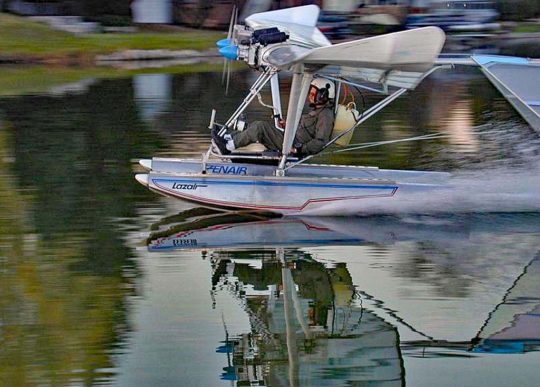
UltraFlight enjoyed a very loyal group of owners and builders in both the U.S. and Canada. Problems were reported with both the Pioneer Chainsaw engines and Rotax engines; several articles describe troubleshooting reports on the Lazair. Parts available from New Lazair via their blog page. In this video, learn more about what is available from Gene Yarbrough, proprietor of Lazair Nouveau.
At the time of production of this video The Ultralight Flyer would estimate the resale value of a used Lazair ultralight to be between $3,500 to $6,500. Gene estimated that between 1,200 and 2,000 Lazair ultralights were sold.
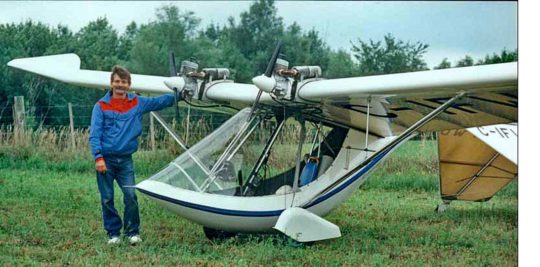
The same commenter claimed TUF’s “price for a used Lazair [shown above] is way too high; around $1,000 is all one is worth.” This person advises, “a lot have damage to the airframe that needs to be repaired and the wing and tail surfaces will most likely need to be recovered. Most have been flipped on their back and the wing tips have been bent slightly. The foam ribs are a bit of hassle and should be replaced. The plastic wheel hubs deteriorate and will break over time. They were custom formed and are no longer available. The axle will have to be rebuilt and new wheel hubs installed,” but the commenter goes on to say that “Azusa three-quarter-inch axle bearings work well and Azusa brand brakes will also do a good job.”
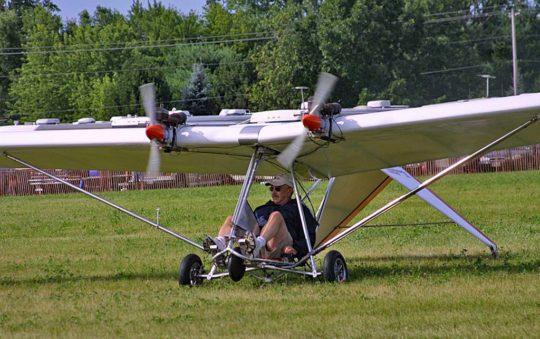
The commenter’s summary: “Total cost would be around $10,000 to fix it properly.” With such an investment, you could claim one of the most intriguing aircraft anyone will see. It will definitely draw looks everywhere you fly Lazair.
For something completely different, you might try electric motors on Lazair. Original developer Dale Kramer adapted off-the-shelf electric components and tells us more in this video.


Dan
What’s the latest and greatest covering for the Lazair.
I have no new info. A link was provided in the article. It still functions although the last update appears to be from 2019.
Thanks
I want to obtain a blueprint of the aircraft and make it myself. How can I get Lazair? proking@126.com
I’m looking to sell a Lazair III that was my Dad’s, C-IGKY. Located 30m north of Toronto, ON, Canada – it was restored, and never got to fly. Been stored indoors since 2007. Engines: 2 Twin, Propellers were new.
Reach out to me, p s a u l e s l [at] gmail [dot] com if you are interested.
How much? Pics?
Do you still have this ac email me at trhudgin@gmail.com to let me know very interested. Tom
Hello,
Is she still available?
My number is 905 246 0485
Thank you, Britt
Sorry All, it was sold.
A nice person with lots of prior Lazair experience bought it, and had it flying in the autumn!
I have a Type II Lazair with Rotax 185s and the upper positioned control stick. it was built by a local young farmer with no flight training or experience. It was never Registered.
On his first flight he tried to fly it in high wind conditions. He tried to land repeatedly but the wind wouldn’t allow him to.
Eventually he did land, but it was a hard landing. The only damage to the Lazair was
[1] a ripple in the upper triangular gusset at the front leading edge of one wing
[2] the plastic nose wheel type skid cracked badly. I removed this.
From what he told me, the total flight time is under 20 minutes. He never tried to fly again, as His Wife forbid him from trying to fly it ever again; I think it scared him big-time!
I bought it from him in the 80’s and have had it stored ever since in my garage.
The Tedlar has deteriorated; tape has become unglued at some edges over the years, so needs to be recovered.
I have added castoring tail wheels to the tail assembly.
Due to age (69) and health, perhaps it’s time to let it go. It’s in Regina, SK., Canada.
Have you got a pic(s)? What is the price? I can be reached at 519-677-5935 or norm@graveldoctor.com. Look forward to your response. Thanks.
Is this plane still available
Use the links in the article to contact Gene Yarbrough, proprietor of Lazair Nouveau. At the time of writing, parts were the focus.
Pics of craft and bad things (???—Ed.) and also the price? Tnx!
Hi. I’m in search for a covering kit or 100′ x 60″ Tedlar. A friend passed away and left me his Lazair II and in trying to complete it in memory of him. Please help with the search for the Tedlar or any donations of the Tedlar needed. Thank you.
Is there anyone with Tedlar and PVF tape for sale or wants to go together on purchasing some? In searching for suppliers I’ve come across reference of there having been special order manufacturing of thicker gauge TTR20SG4 material. Does anyone know of this? I see there is some slight reduction in performance of the film if it is tinted. I was thinking that possibly someone might have had a batch of tinted material made with a thicker gauge that would offset some of the loss of performance that resulted from the addition of tint. Does anyone know anything of this?
This is my first time posting… please cut me some slack (thanks). I have an interest in purchasing a Lazair… any suggestions where I can find one? Thanks, Norm. —please email to: norm@graveldoctor.com
Welcome to posting, Ron. ByDanJohnson.com is a pretty safe place to post. This is not remotely like social media. I moderate every post and I won’t tolerate abusive comments. The good news is, I’ve only ever had to scrub two messages that I judged to be inappropriate.
As to Lazair, well, I understand used ones move pretty fast and the supply is not large. Stay up on Lazair Nouveau at their blog.
I purchased a Series II aircraft that was approx. 80% completed (some say that means 80% to go). After the builder had health issues the aircraft was never completed and was stored inside his 35×25 barn built for the purpose of building ultra lite aircraft. He built and flew 2 others (different manufacturers) before buying and beginning the build on this Lazair. The aircraft has been stored in this building ever since. I bought the aircraft and the house with building at an estate auction in 2010. He had mostly completed the build including Tedlar covering on the tail sections, ailerons, and one wing tip. I have a box with some parts, cables, Tedlar, fight manual, build manual and technical bulletins. Now, after 10 years of dreaming about finishing and flying this aircraft I am selling the property and am faced with moving the plane or selling it. I had hoped to trailer it to Oshkosh for a fly-in to meet folks interested in this aircraft and maybe get some help finishing and flying it. So, if anyone is interested in helping me with that endeavor, providing advise or even purchasing this unfinished kit just contact me. Regards. Doug.
Doug, Please contact me via email regarding possible sale of Lazair. I should be notified via email if you reply to this comment.
I know your purpose here (that’s fine) but it is not certain the manufacturer will see this request.
Hello Doug. Mr. Bill from St Louis, MO just wondering how the project is going, if it was sold, and if not, can I chat with you about obtaining the project.
Thanks,
Bill Jagust ATP/CFI/A&P
bsarj@cs.com
314-494-3987
I am very interested if it is still available.
The Lazair was clearly derived from the Klaus Hill SuperFloater if you look at the drawings. Other than the V-tail they are almost similar with only a 4-foot difference in span. Looks like one can be built from the SuperFloater drawings which are floating around.
Khalid: I know quite a bit about SuperFloater, as I licensed the design and set up manufacturing (as US Aviation) to sell a modernized version. I can say with some assurance that Lazair and SuperFloater do not have much in common. We all see things differently but I do not agree that Lazair is “clearly derived from …SuperFloater.” The only way to know for sure is to ask Canadian Lazair developer, Dale Kramer.
Thanks for the reply.I find a lot of similiarities between the Klaus Hill super floater and non between the US aviation aircraft which is more like a copy of the vj24.
Regards
Looking for a set of plans for the Lazair. I am willing to pay for the copies.
By all means, contact Gene Yarbrough of Lazair Nouveau. Links are included in the article.
I was at Tullahoma in 1980 and watched Peter fly. My Dad was a dealer for Lazair. I flew my Lazair last week. For reliable information on Lazairs pulling info from YouTube comments probably isn’t the best idea. There were around 1,000 Lazairs made. Peter Corley also helped develop the Falcon Ultralight and went on to make the Toucan of which a few flying examples exist. Remarkable intelligent friendly guy and excellent pilot.
Years ago there was a Lazair with 4 engines flying in Australia. Did anyone have pictures of it?
Hi. My name is Fernando and, yes, I have pictures of this Lazair. In fact I am the owner and builder of this aircraft but it’s no longer in Australia. It’s now in Portugal and last flew in 2001.
Gene Y is an aero engineer and has done a marvelous job of strengthening the airframe for heavier pilots and preparing his Nouveau Lazair for kit production. But we don’t see much development on that front. Wish him every success with restoring this classic aircraft to the market.
Any Lazair that I have seen come up for sale on the used market is gone in a few days. Very seldom does one get listed and usually only locally.
A truly fascinating design.